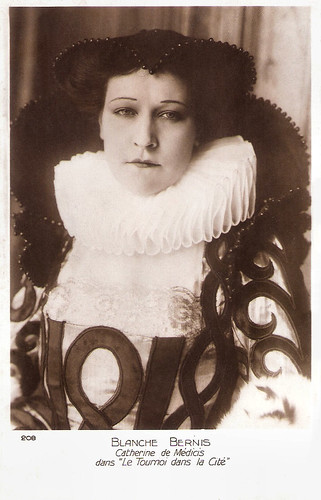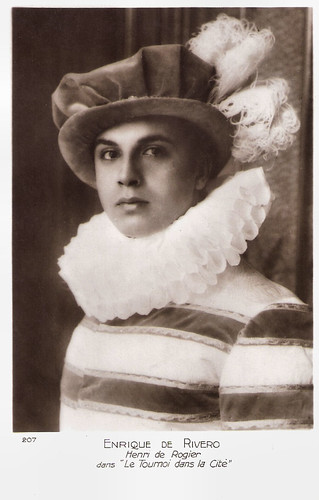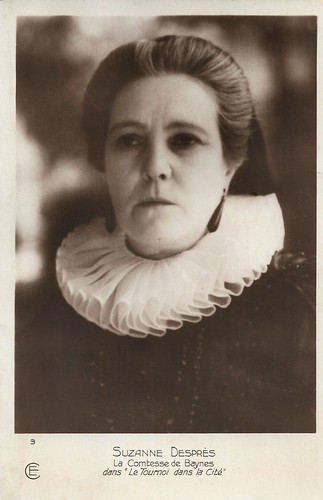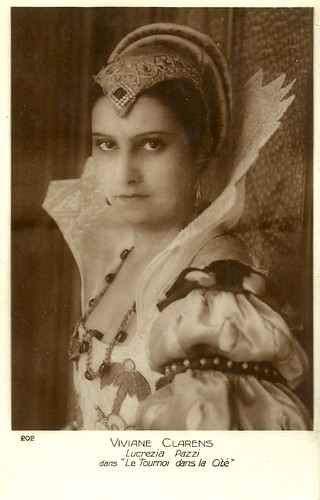Le tournoi dans la cité/The Tournament (1928) was one of the last silent films of director Jean Renoir. The lavish historical film was scripted by Henry Dupuis-Mazuel. Sets were designed by Robert Mallet-Stevens, and costumes by George Barbier. The exteriors were shot in the medieval French city of Carcassonne.

French postcard by Cinémagazine-Edition, no. 208. Photo: publicity still for Le tournoi dans la cité/The Tournament (Jean Renoir, 1928), with Blanche Bernis as Cathérine de Médicis.

French postcard by Cinémagazine-Edition, no. 210. Photo: publicity still for Le tournoi dans la cité/The Tournament (Jean Renoir, 1928), with Jackie Monnier as Isabelle Ginori.
The story of Le tournoi dans la cité takes place in 16th Century France, during the reign of the young King Charles IX (Gérard Mock) and his mother Catherine de Medici (Blanche Bernis). The beautiful Isabelle Ginori (Jackie Monnier) becomes engaged to a Catholic gentleman, Henri de Rogier (Enrique Rivero).
Unfortunately, the cruel Protestant leader François de Baynes (Aldo Nadi) meets Isabelle and declares in lively terms that she will belong to him. Count Ginori (Manuel Raabi), the girl's relative, declines the proposal, so François kills him in a duel. For political reasons, the Queen is ready to unite Isabelle and François, but a mistress of the latter, Lucrezia Pazzi (Viviane Clarens), intervenes.
Catherine decides that the winner of the tournament will become Isabelle's husband. François surpasses his rival, but the corpse of Ginori is discovered and the culprit unmasked. Charged by the guard, François succumbs. Isabelle and Henri may finally become engaged.
Who were the actors in this little known film by Jean Renoir? Jackie Monnier would return in Renoir's final silent film, Le Bled/The Bled (Jean Renoir, 1929). She also appeared in G.W. Pabst's Westfront 1918 (1930) and some 10 other films.
The hero, Chilean actor Enrique Rivero, would become famous for his part in Jean Cocteau's Le sang d'un poète/The Blood of a poet (1930). For a time he was known as the European Rudolph Valentino. Aldo Nadi was a professional fencer, who had one of his rare film roles here. Years later, he played a bodyguard in the Humphrey Bogart classic To Have and To Have Not (Howard Hawks, 1944).
Little is known about Blanche Bernis, who had a career in late 1920s and 1930s French film. She first played a prostitute in Alberto Cavalcanti's city symphony Rien que les heures (1926). Her debut was followed by a peak in 1928 films: Cavalcanti's Guy de Maupassant adaptation Yvette (1928) and his En Rade (1928), both starring Catherine Hessling, Renoir's Le tournoi dans la cité (1928), plus Ewald André Dupont's Moulin Rouge (1928), starring Olga Tschechova.
In 1929 she played in L'arpète by Donatien, starring Lucienne Legrand. In the sound era, Bernis acted in three films: the drama Le train des suicidés (Edmond T. Gréville, 1931), Judex 34 (Maurice Champreux, 1934), and Gosse de Riche (Maurice de Canonge, 1938), starring Madeleine Robinson and Pierre Brasseur.

French postcard by Cinémagazine-Edition, no. 207. Photo: publicity still for Le tournoi dans la cité/The Tournament (Jean Renoir, 1928), with Enrique (de) Rivero as Henri de Rogier.
Le tournoi dans la cité/The Tournament (Jean Renoir, 1928) was commissioned by Société des Films Historiques, a historical society to commemorate 500 years of history of the medieval French city of Carcassonne, where the film was made.
According to D.B. DuMonteil at IMDb, director Jean Renoir did not take the consignment seriously: "It's the (modest) granddaddy of La Reine Margot and other costume dramas in the catholic vs protestants background. It seems that the director had a comfortable budget at his disposal, but it's far from being more than a footnote in his oeuvre."
While the first night of Le tournoi dans la cité/The Tournament (1928) took place in Brussels in December 1928, the Parisian premiere was on 9 February 1929 at the cinema Marivaux. For many years this silent Renoir was considered lost, except for an abbreviated 40-minute print that could only have provided a tantalising hint of the splendour of the original feature.
Michael Neumann at IMDb calls the restored film 'a handsome medieval romance': "Agile camera-work and painterly lighting effects lend momentum to a drama which otherwise has a tendency to become bogged down in narrative exposition and meticulous period detail, up until the stirring climactic joust."
And the anonymous author at BAMPFA adds: "Although Renoir confessed an aversion to the 'pageantry' genre, he took the opportunity to invent some bravura camera strokes (including at least one magnificently conceived tracking shot) and invested the film with an impressive realism of place (shooting the exteriors in Carcassone), historical detail, and psychology. The highlight of the film is its beautifully staged tournaments and jousts, for which Renoir employed the members of the famous riding school in Samour."

French postcard by Cinémagazine-Edition, no. 3. Photo: publicity still for Le tournoi dans la cité/The Tournament (Jean Renoir, 1928), with Suzanne Desprès as La Comtesse de Baynes.

French postcard by Cinémagazine-Edition, no. 202. Photo: publicity still for Le tournoi dans la cité/The Tournament (Jean Renoir, 1928), with Viviane Clarens as Lucrezia Pazzi.
Sources: Michael Neumann (IMDb), D.B. DuMonteil (IMDb), BAMPFA, Wikipedia and IMDb.

French postcard by Cinémagazine-Edition, no. 208. Photo: publicity still for Le tournoi dans la cité/The Tournament (Jean Renoir, 1928), with Blanche Bernis as Cathérine de Médicis.

French postcard by Cinémagazine-Edition, no. 210. Photo: publicity still for Le tournoi dans la cité/The Tournament (Jean Renoir, 1928), with Jackie Monnier as Isabelle Ginori.
The winner of the tournament will be Isabelle's husband
The story of Le tournoi dans la cité takes place in 16th Century France, during the reign of the young King Charles IX (Gérard Mock) and his mother Catherine de Medici (Blanche Bernis). The beautiful Isabelle Ginori (Jackie Monnier) becomes engaged to a Catholic gentleman, Henri de Rogier (Enrique Rivero).
Unfortunately, the cruel Protestant leader François de Baynes (Aldo Nadi) meets Isabelle and declares in lively terms that she will belong to him. Count Ginori (Manuel Raabi), the girl's relative, declines the proposal, so François kills him in a duel. For political reasons, the Queen is ready to unite Isabelle and François, but a mistress of the latter, Lucrezia Pazzi (Viviane Clarens), intervenes.
Catherine decides that the winner of the tournament will become Isabelle's husband. François surpasses his rival, but the corpse of Ginori is discovered and the culprit unmasked. Charged by the guard, François succumbs. Isabelle and Henri may finally become engaged.
Who were the actors in this little known film by Jean Renoir? Jackie Monnier would return in Renoir's final silent film, Le Bled/The Bled (Jean Renoir, 1929). She also appeared in G.W. Pabst's Westfront 1918 (1930) and some 10 other films.
The hero, Chilean actor Enrique Rivero, would become famous for his part in Jean Cocteau's Le sang d'un poète/The Blood of a poet (1930). For a time he was known as the European Rudolph Valentino. Aldo Nadi was a professional fencer, who had one of his rare film roles here. Years later, he played a bodyguard in the Humphrey Bogart classic To Have and To Have Not (Howard Hawks, 1944).
Little is known about Blanche Bernis, who had a career in late 1920s and 1930s French film. She first played a prostitute in Alberto Cavalcanti's city symphony Rien que les heures (1926). Her debut was followed by a peak in 1928 films: Cavalcanti's Guy de Maupassant adaptation Yvette (1928) and his En Rade (1928), both starring Catherine Hessling, Renoir's Le tournoi dans la cité (1928), plus Ewald André Dupont's Moulin Rouge (1928), starring Olga Tschechova.
In 1929 she played in L'arpète by Donatien, starring Lucienne Legrand. In the sound era, Bernis acted in three films: the drama Le train des suicidés (Edmond T. Gréville, 1931), Judex 34 (Maurice Champreux, 1934), and Gosse de Riche (Maurice de Canonge, 1938), starring Madeleine Robinson and Pierre Brasseur.

French postcard by Cinémagazine-Edition, no. 207. Photo: publicity still for Le tournoi dans la cité/The Tournament (Jean Renoir, 1928), with Enrique (de) Rivero as Henri de Rogier.
A footnote in Renoir's oeuvre
Le tournoi dans la cité/The Tournament (Jean Renoir, 1928) was commissioned by Société des Films Historiques, a historical society to commemorate 500 years of history of the medieval French city of Carcassonne, where the film was made.
According to D.B. DuMonteil at IMDb, director Jean Renoir did not take the consignment seriously: "It's the (modest) granddaddy of La Reine Margot and other costume dramas in the catholic vs protestants background. It seems that the director had a comfortable budget at his disposal, but it's far from being more than a footnote in his oeuvre."
While the first night of Le tournoi dans la cité/The Tournament (1928) took place in Brussels in December 1928, the Parisian premiere was on 9 February 1929 at the cinema Marivaux. For many years this silent Renoir was considered lost, except for an abbreviated 40-minute print that could only have provided a tantalising hint of the splendour of the original feature.
Michael Neumann at IMDb calls the restored film 'a handsome medieval romance': "Agile camera-work and painterly lighting effects lend momentum to a drama which otherwise has a tendency to become bogged down in narrative exposition and meticulous period detail, up until the stirring climactic joust."
And the anonymous author at BAMPFA adds: "Although Renoir confessed an aversion to the 'pageantry' genre, he took the opportunity to invent some bravura camera strokes (including at least one magnificently conceived tracking shot) and invested the film with an impressive realism of place (shooting the exteriors in Carcassone), historical detail, and psychology. The highlight of the film is its beautifully staged tournaments and jousts, for which Renoir employed the members of the famous riding school in Samour."

French postcard by Cinémagazine-Edition, no. 3. Photo: publicity still for Le tournoi dans la cité/The Tournament (Jean Renoir, 1928), with Suzanne Desprès as La Comtesse de Baynes.

French postcard by Cinémagazine-Edition, no. 202. Photo: publicity still for Le tournoi dans la cité/The Tournament (Jean Renoir, 1928), with Viviane Clarens as Lucrezia Pazzi.
Sources: Michael Neumann (IMDb), D.B. DuMonteil (IMDb), BAMPFA, Wikipedia and IMDb.
No comments:
Post a Comment